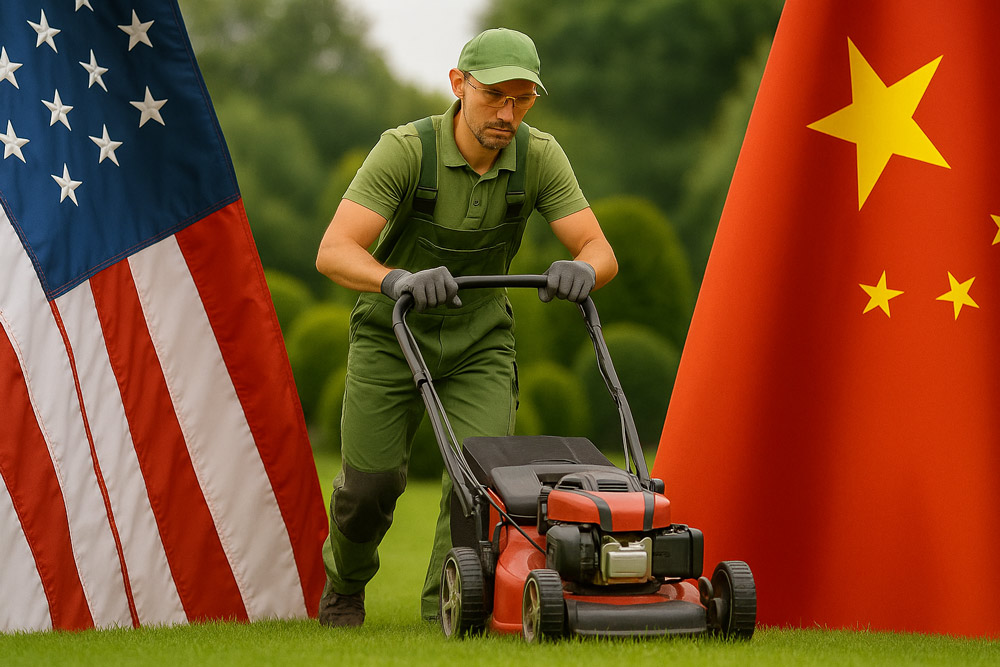What Are the 2025 U.S.-China Tariffs?
In April 2025, the U.S. government implemented sweeping new tariffs on Chinese imports, including landscaping equipment, fertilizer products, herbicides, and electrical components. These tariffs average 145%, drastically raising the cost of goods imported from China (source). In response, China has imposed its own retaliatory tariffs, fueling fears of prolonged trade disruption.
For the lawn care and landscape maintenance sectors, these tariffs touch nearly every piece of the supply chain.
How Tariffs Affect Lawn and Landscape Maintenance Businesses
1. Lawn Equipment and Replacement Parts Costs Surge
Many lawn mowers, blowers, string trimmers, and chainsaws—whether fully assembled or containing key components—are manufactured in China. With the 145% tariff, prices are skyrocketing.
- Example: A mower that cost $1,000 pre-tariff could now exceed $2,400 after duties and markups.
- Replacement Parts: Even U.S.-assembled equipment often includes Chinese parts, so repairs and maintenance are becoming pricier.
Keywords: tariffs on lawn equipment, lawn mower price increase, landscaping equipment tariffs
2. Irrigation Systems and Components Face Higher Costs
Irrigation systems are critical for the lawn care industry, particularly in drought-prone regions. Many components—like sprinkler valves, controllers, drip emitters, and timers—are sourced from China.
- Impact: Expect 15–30% increases on irrigation materials, which could affect both new installations and repairs.
- Delays: Longer customs times and port congestion are already being reported (source), leading to supply shortages.
Keywords: tariffs on irrigation systems, irrigation component costs, landscape irrigation price hike
3. Fertilizers, Herbicides, and Agrochemicals Become More Expensive
Many fertilizers and herbicides (like 2,4-D) are imported from China or rely on raw materials sourced there. The 145% tariffs on these products increase input costs significantly.
- Price Impact: Agrochemicals could rise 20–40%, squeezing margins for landscape contractors, golf courses, and sports turf managers.
- Supply Chain Risk: Potential shortages could force businesses to source less familiar (or costlier) alternatives.
Keywords: tariffs on fertilizers, herbicide costs 2025, landscape chemical supply chain
4. Electric Lawn Equipment Prices Rise
With the push for more eco-friendly electric lawn equipment like battery-powered mowers and trimmers, many businesses were transitioning away from gas tools. Unfortunately, most electric landscaping equipment or their lithium-ion batteries come from China.
- Tariff Impact: Prices for electric equipment are up 30–50% in some cases, slowing adoption rates for sustainable lawn care solutions.
Keywords: electric lawn equipment tariffs, battery-powered lawn tools cost, sustainable lawn care challenges
5. Shipping, Fuel, and the Full Cost of Goods Sold (COGS)
Tariffs don’t just hit products directly. They ripple through shipping, fuel, and logistics, raising the total cost of goods sold (COGS).
- Fuel Prices: Shipping costs rise with tariffs, and fuel prices are edging up as a result.
- Logistics: More expensive freight rates and longer delivery times cause operational headaches.
Keywords: shipping cost increase tariffs, fuel prices landscape industry, landscape business COGS 2025
Preparing Your Lawn and Landscape Business for Tariffs
1. Diversify Your Supply Chain
Look beyond China. Source equipment, irrigation parts, and chemicals from other countries or local manufacturers.
- Tip: Focus on Made in USA landscaping products or explore suppliers in Mexico, Vietnam, or India.
Keywords: landscape supply alternatives to China, domestic lawn equipment suppliers
2. Invest in Durable, Quality Equipment
Higher-quality tools may cost more upfront but offer longer lifespans and lower repair costs, buffering you against supply chain shocks.
- Prioritize durability and ease of maintenance.
Keywords: durable landscaping equipment, best long-lasting lawn tools
3. Optimize Chemical and Water Use
Implement integrated pest management (IPM) and precision irrigation to reduce reliance on high-cost inputs.
- Less fertilizer, herbicide, and water use = lower operational costs.
Keywords: integrated pest management landscaping, reduce chemical use lawn care, precision irrigation benefits
4. Bulk Purchase Before Price Hikes
Stock up on essential supplies like herbicides, fertilizers, and irrigation parts while prices are still manageable.
- Coordinate with suppliers for volume discounts.
Keywords: bulk lawn care supplies, landscape supply discounts
5. Adjust Pricing Transparently
Explain to clients why landscaping costs might rise. Most will understand if you communicate openly about global trade pressures.
- Build trust by sharing how you’re proactively managing costs.
Keywords: landscape pricing strategy 2025, communicating price increases clients
Final Thoughts: Stay Informed and Adapt
The 145% tariffs on Chinese imports could reshape the lawn care and landscape maintenance industry over the coming months. With equipment costs rising, chemical supplies tightening, and logistics getting pricier, staying ahead of these changes is critical.
By diversifying suppliers, investing in durable tools, and optimizing inputs, your business can weather the storm and continue to thrive.
FAQs (For SEO)
Q: How will U.S.-China tariffs affect lawn care businesses in 2025?
A: The tariffs will raise the prices of lawn equipment, fertilizers, irrigation parts, and shipping, increasing operational costs across the lawn care and landscape industry.
Q: Are there alternatives to Chinese landscaping supplies?
A: Yes. Many suppliers in the U.S., Mexico, India, and Vietnam offer alternatives for lawn equipment, chemicals, and irrigation components.
Q: How can I reduce the impact of tariffs on my landscaping business?
A: Diversify your suppliers, invest in durable equipment, reduce chemical and water usage, bulk purchase supplies, and adjust client pricing strategies.

